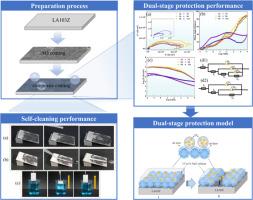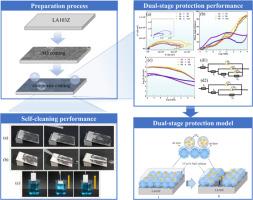Superhydrophobic coatings with enhanced adhesion for LA103Z alloy: Barrier-passivation synergy toward robust dual-stage corrosion protection
IF 5.6
3区 材料科学
Q1 ELECTROCHEMISTRY
引用次数: 0
Abstract
Developing durable superhydrophobic coatings is of great significance for enhancing the service performance of Mg-Li alloys. Herein, this study employs synergistic anodic oxidation-electrodeposition (AO-ED) technology to develop a superhydrophobic composite coating with hierarchical micro-nano structures on LA103Z alloy. Combining enhanced corrosion resistance, robust adhesion and self-cleaning functionality in one system, this coating significantly extends material lifespan. The synergistic interaction between the Mg(OH)2 interlayer and the functional Ca[CH₃(CH₂)₁₂COO]₂ layer enhance the coating adhesion from Grade 2 to Grade 1. Electrochemical measurements reveal that the composite coating exhibits an ultralow corrosion current density (Icorr) of 2.80×10−⁸ A·cm−². Composite coating possesses a high charge transfer resistance (Rct) of 2.47×10⁶ Ω·cm², representing a four-order-of-magnitude improvement over the bare substrate. The composite coating achieves long-term corrosion protection in 3.5 wt.% NaCl solution through a dynamic dual-stage mechanism. During the initial corrosion stage (0–7 days), the composite coating delays electrolyte penetration through the Cassie-Baxter superhydrophobic air cushion barrier effect (contact angle = 157.9°). In the subsequent protective phase (>7 days), long-term corrosion resistance is sustained by in-situ formation of a dense passivation film within the anodic layer, synergistically coupled with interfacial stability to maintain system impedance on the order of 10⁴ Ω·cm².


LA103Z合金的超疏水涂层附着力增强:屏障-钝化协同作用实现强大的双级腐蚀防护
开发耐用的超疏水涂层对提高镁锂合金的使用性能具有重要意义。本研究采用协同阳极氧化-电沉积(AO-ED)技术,在LA103Z合金表面制备了具有层次微纳结构的超疏水复合涂层。在一个系统中结合增强的耐腐蚀性,强大的附着力和自清洁功能,该涂层显着延长了材料的使用寿命。Mg(OH)2中间层与官能层Ca[CH₃(CH₂)₁₂COO]₂之间的协同作用使涂层的附着力从2级提高到1级。电化学测量表明,复合涂层具有超低的腐蚀电流密度(Icorr),为2.80×10−⁸A·cm−²。复合涂层具有极高的电荷转移电阻(Rct),为2.47×10 26 Ω·cm²,比裸基板提高了4个数量级。复合涂层在3.5 wt.% NaCl溶液中通过动态双阶段机制实现长效防腐。在腐蚀初期(0-7天),复合涂层通过Cassie-Baxter超疏水气垫屏障效应(接触角 = 157.9°)延缓了电解质的渗透。在随后的保护阶段(>;7天),通过在阳极层内原位形成致密的钝化膜来维持长期的耐腐蚀性,协同作用与界面稳定性相结合,以维持10⁴Ω·cm²量级的系统阻抗。
本文章由计算机程序翻译,如有差异,请以英文原文为准。
求助全文
约1分钟内获得全文
求助全文
来源期刊

Electrochimica Acta
工程技术-电化学
CiteScore
11.30
自引率
6.10%
发文量
1634
审稿时长
41 days
期刊介绍:
Electrochimica Acta is an international journal. It is intended for the publication of both original work and reviews in the field of electrochemistry. Electrochemistry should be interpreted to mean any of the research fields covered by the Divisions of the International Society of Electrochemistry listed below, as well as emerging scientific domains covered by ISE New Topics Committee.
 求助内容:
求助内容: 应助结果提醒方式:
应助结果提醒方式:


